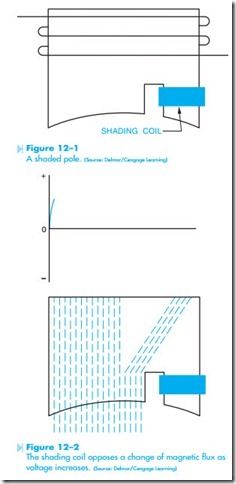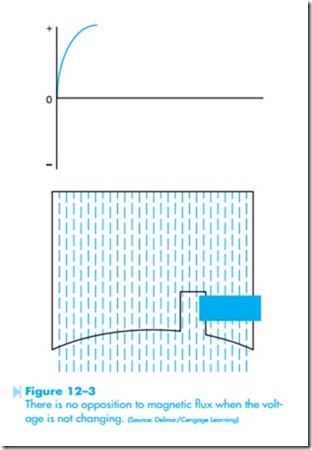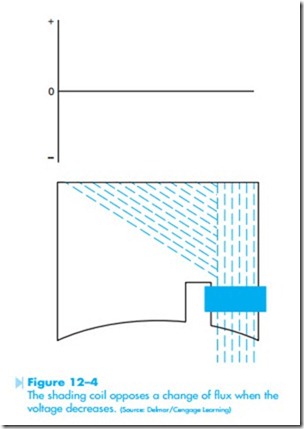The Shaded- Pole Induction Motor
The shaded-pole induction motor is another type of AC single-phase motor used to a large extent in the air conditioning field. This motor is popular because of its simplicity and long life. The shaded- pole motor contains no start winding or centrifugal switch. The rotating magnetic field is created by a shading coil wound around one side of each pole piece.
THE SHADING COIL
The shading coil is wound around one end of the pole piece, Figure 12–1. The shading coil is actually a large loop of copper wire or a copper band. Both ends of the loop are connected together to form a complete circuit. The shading coil acts in the same manner as a transformer with a shorted secondary winding. When the voltage of the AC
waveform increases from zero toward its positive peak, a magnetic field is created in the pole piece. As magnetic lines of flux cut through the shading coil, a voltage is induced in the coil. Because the coil is a low-resistance short circuit, a large amount of current flows in the loop. This current flow causes an opposition to the change of magnetic flux, Figure 12–2. As long as voltage is induced into the shading coil, there will be an opposition to the change of magnetic flux.
When the AC voltage reaches its peak value, it is no longer changing and there is no voltage being induced into the shaded coil. Since there is no current flow in the shading coil, there is no opposition to the magnetic flux. The magnetic flux of the pole piece is now uniform across the pole face, Figure 12–3.
When the AC voltage begins to decrease from its peak value back toward zero, the magnetic field of the pole piece begins to collapse. A current is again induced into the shading coil. The induced current opposes the change of magnetic flux, Figure 12–4.This causes the magnetic flux to be concentrated in the shaded section of the pole piece.
When the AC voltage passes through zero and begins to increase in the negative direction, the same set of events happen, except that the polarity of the magnetic field is reversed. If these events were to be
seen in rapid order, it could be seen that the magnetic field rotates across the face of the pole piece.
SPEED
The speed of the shaded-pole induction motor is determined by the same factors that determine the synchronous speed of other induction motors: frequency and number of stator poles. Shaded-pole motors are commonly wound as four- or six-pole motors. Figure 12–5 shows a drawing of a four- pole motor.
EVERSING DIRECTION OF ROTATION
The direction the magnetic field moves across the face of the pole piece is determined by the side of the pole piece that has the shaded coil. The rotor will turn in the direction of the shaded pole as shown by the arrow in Figure 12–5. If the direction of rotation must be changed, it can be done by removing the stator winding and turning it around. This is not a common practice, however. As a general rule, the shaded-pole induction motor is considered to be nonreversible.


